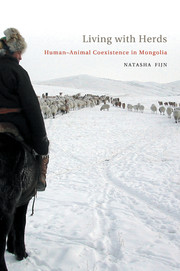Book contents
- Frontmatter
- Contents
- Lists of Plates, Figures, Maps, Tables, and Online Video Segments
- Glossary
- Acknowledgments
- LIVING WITH HERDS
- PART ONE CROSSING BOUNDARIES
- PROLOGUE: LIFE IN THE KHANGAI MOUNTAINS
- 1 INTRODUCTION
- 2 A MONGOLIAN ETHO-ETHNOGRAPHY
- PART TWO THE SOCIAL HERD
- PART THREE LIVING WITH HERDS
- Appendix
- References
- Index
- Plate section
2 - A MONGOLIAN ETHO-ETHNOGRAPHY
from PART ONE - CROSSING BOUNDARIES
Published online by Cambridge University Press: 03 May 2011
- Frontmatter
- Contents
- Lists of Plates, Figures, Maps, Tables, and Online Video Segments
- Glossary
- Acknowledgments
- LIVING WITH HERDS
- PART ONE CROSSING BOUNDARIES
- PROLOGUE: LIFE IN THE KHANGAI MOUNTAINS
- 1 INTRODUCTION
- 2 A MONGOLIAN ETHO-ETHNOGRAPHY
- PART TWO THE SOCIAL HERD
- PART THREE LIVING WITH HERDS
- Appendix
- References
- Index
- Plate section
Summary
INTRODUCTION
Throughout my descriptions in the etho-ethnographic chapters that follow, I aim to show that Mongolian herders view their herd animals as agents who participate in a reciprocal, co-domestic relationship. This level of coexistence requires a relationship that is based on trust and respect, as the herd animals are contained to a minimal extent yet choose to associate with the herding family of their own accord. The reciprocity between herder and herd animal works because they live in close proximity to one another within a core area, the “co-domestic sphere.” My approach towards the human–other animal relationship is similar to Tim Ingold's in that we both aim to cross preconceived disciplinary boundaries between the natural sciences and the humanities and to take care to avoid the traditional dichotomy of nature versus culture. I do differ, however, from Ingold's conclusions with reference to a frequently cited paper on human–other animal engagement and domestication entitled “From Trust to Domination: An Alternative History of Human–Animal Relations” (1994). Within this chapter I discuss my contrasting view based on observations from the field with regard to Mongolian herders as pastoralists and their attitudes towards their herd animals.
There has been a tendency in literature on nomadic pastoralism to unify all peoples together under a common framework (Barfield 1993; Dyson-Hudson & Dyson-Hudson 1980; Ingold 1994; Khazanov 1994). Instead of discussing the animals as property, commodities, or as metaphors for human behaviour, my focus is on the herd animals as actors in their own right.
- Type
- Chapter
- Information
- Living with HerdsHuman-Animal Coexistence in Mongolia, pp. 36 - 52Publisher: Cambridge University PressPrint publication year: 2011



